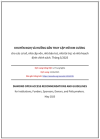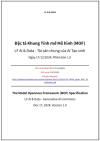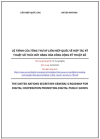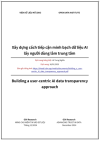Toshihiro Suzuki, Giám đốc Cao cấp về Kiến trúc và Chiến lược Tiêu chuẩn, Oracle
Ngày 03/08/2007
Theo: http://www.odfalliance.org/resources/Oracle%20Comments%20on%20DIS%2029500.pdf
Technical Comments on DIS 29500
Martin Chapman, Consulting Member of Technical Staff, Oracle
Toshihiro Suzuki, Standards Strategy and Architecture Senior Director, Oracle
August 3, 2007
Lời người dịch: Chúng ta đã được xem các bình luận kỹ thuật về DIS 29500 của IBM trong bài viết trên blog này ngày 09/07/2007 với đầu đề “Bạn sẽ thất vọng tràn trề” khi IBM tư vấn cho chính phủ Séc. Còn lần này là của Oracle.
Trong giai đoạn xem xét lại đặc tả kỹ thuạt của ECMA OOXML, một số lượng đáng kể các vấn đề đã được đưa ra mà theo ý kiến của chúng tôi thì chúng tạo nên sự nghi ngờ về chất lượng và tính có thể triển khai được của đặc tả kỹ thuật này. Việc tìm cách giải quyết tất cả các vấn đề này theo một cách thoả mãn là không thể trong một khung thời gian cho phép và không phù hợp với qui trình nhanh (Fast Track).
Trường hợp sử dụng đầu tiên của OOXML là “để có khả năng đại diện một cách trung thực tập hợp các tài liệu đã và đang tồn tại sẵn của xử lý văn bản, trình diễn và bảng tính...”. Đưa ra trường hợp sử dụng này, đây là điều quan trọng cực điểm mà phiên bản đầu tiên của đặc tả kỹ thuật này là bằng chứng chứng minh trong tương lai quan trọng nhất có thể được. Mọi thay đổi trong tương lai mà chúng làm ngắt tính tương hợp ngược của các tài liệu sẽ làm trái với trường hợp sử dụng đầu tiên này. Vì thế thời gian phải được bỏ ra để làm cho đặc tả kỹ thuật này đúng với lần đầu này.
During the review period for the ECMA OOXML specification, a substantial number of issues have been raised that in our opinion cast doubt on the quality and implementability of the specification. Tackling all the issues in a satisfactory manner is not possible in the timeframe permitted and is inappropriate for the Fast Track process.
The prime use case of OOXML is "to be capable of faithfully representing the pre-existing corpus of word processing documents, presentations, and spreadsheets...". Given this use case, it is of utmost
importance that the first version of this specification is as future proof as possible. Any changes in the
future that break backwards compatibility of documents will violate the prime use case. Therefore time should be spent to get this specification right the first time.
It is Oracle’s opinion that given the many technical issues that have been raised during this balloting
process, the current specification is not future proof, and hence down the line the prime use case will be violated. There are four areas of concern that must be resolved in order to move forward:
Đây là ý kiến của Oracle được đưa ra với rất nhiều các vấn đề kỹ thuật mà chúng đã được đưa ra trong quá trình biểu quyết này, đặc tả kỹ thuật hiện hành là không chứng minh được tương lai và vì thế không đạt được yêu cầu đối với trường hợp sử dụng đầu tiên sẽ bị vi phạm. Có 4 lĩnh vực liên quan mà chúng phải được giải quyết để tiến được lên phía trước:
Bổ sung các tham chiếu tiêu chuẩn
Loại bỏ VML
Loại bỏ tất cả thẻ “hành động như trình xử lý word X”
Cho phép các số nguyên âm cho các ngày trước năm 1900
1. Addition of Normative References
2. Removal of VML
3. Removal of all "act like word processor X" Tags
4. Allow Negative Integers for Dates Before 1900
Các điểm 2 và 3 đề xuất loại bỏ các mục trong đặc tả kỹ thuật. Thay vì đại diện cho các mở rộng sở hữu độc quyền, nó có thể được chấp thuận để xác định một sơ lược tiểu sử mới thích hợp mà nó sẽ thu thập cùng những thứ đã có và các tính năng sở hữu độc quyền này. Vì vậy, điểm phù hợp ứng dụng hiện hành có thể được chia thành 2, nơi mà sự phù hợp ứng dụng cơ bản không yêu cầu các tính năng đã có đó, và sơ lược tiểu sử phù hợp được bổ sung sẽ hỗ trợ sự phù hợp cơ bản cộng thêm các tính năng đã có đó.
Points 2 and 3 suggest the removal of items f-rom the specification. Rather than delegate to proprietary
extensions, it might be acceptable to define a new conformance profile that collects together these legacy and proprietary features. As such, the current application conformance point could be divided into two, whe-re basic application conformance does not require these legacy features, and the additional conformance profile supports basic conformance plus the legacy features.
1. Missing Normative References
1. Thiếu các tham chiếu tiêu chuẩn
Oracle mong chờ một danh sách đầy đủ các tham chiếu tiêu chuẩn để đưa vào ít nhất là XML 1.0, Lược đồ XML (Chương 1, 2 và 3), và đặc tả kỹ thuật định dạng tệp nén .Zip trong các tham chiếu tiêu chuẩn. Hơn nữa phiên bản của Zip cần được xác định như theo các chỉ thị của JTC1 (tham chiếu tiêu chuẩn hiện hành chỉ ra một cách hữu hiệu cho “phiên bản mới nhất” mà nó có thể thay đổi). Một danh sách đầy đủ được đưa vào trong phụ lục A.
Theo các chỉ thị của JTC1, mọi tham chiếu tiêu chuẩn mà chúng không là các tiêu chuẩn quốc tế, phải tới từ một Tổ chức Tham chiếu Được chấp thuận – ARO (Approved Referencing Organization) hoặc phải được đi kèm với một báo cáo giải thích tham chiếu – RER (Referencing Explanatory Report). Lưu ý rằng từ tháng 01/2007, W3C là một ARO.
Oracle expects a complete list of normative references to include at least see XML 1.0, XML Schema
(parts 1, 2 and 3), and .Zip File Format Specification in the normative references. Furthermore the version of Zip needs to be defined as per JTC1 directives (the current informative reference effectively points to "the latest version" which can change.) A complete list is included in appendix A.
Under JTC1 directives, any normative references that are not International standards, must either come f-rom an Approved Referencing Organization (ARO), or must be accompanied by a Referencing
Explanatory Report (RER). Note that as of January 2007, W3C is an ARO.
2. Removal of Dependencies on Proprietary Technologies
2. Tài nguyên tham chiếu của VML (Chương 4 phần 6) chứa một số các tham chiếu sở hữu độc quyền. Chúng đưa vào các tham chiếu và địa danh đặc trưng của Microsoft cho các siêu định dạng tệp của Windows, và sự phụ thuộc vào các phiên bản đặc biệt của Internet Explorer.
Sau đó, thuộc tính “đích - target” (Đích Hiển thị Siêu liên kết) của một vài yếu tố có các giá trị “_media” và “_search”. Mô tả này cho chúng là như sau một cách tương ứng (xem trang 4371 về OOXML Chương làm ví dụ):
“_media”: Chỉ định rằng tài liệu được liên kết này được tải vào trong Media Bar. Có sẵn trong Microsoft Internet Explorer 6 hoặc mới hơn.
“_search”: Chỉ định rằng tài liệu được liên kết này được tải vào trong khung tìm kiếm của trình duyệt. Có sẵn trong Microsoft Internet Explorer 5 hoặc mới hơn.
Những phụ thuộc độc quyền sở hữu rõ ràng này không có chỗ trong một tiêu chuẩn quốc tế vì thể xem xét phải được đưa ra để loại bỏ khu 6.
The VML Reference Material (Part 4 Section 6) contains a number of proprietary references. These
include Microsoft specific namespaces, references to Windows meta file formats, and dependency on
specific versions of Internet Explorer.
On the later, the "target" attribute (Hyperlink Display Target) of several elements has values "_media" and "_search". The description for them is as follows respectively (refer to p4371 of OOXML Part 4, for example);
"_media" : Specifies that the linked document is loaded into the Media Bar. Available in Microsoft Internet Explorer 6 or later.
"_search": Specifies that the linked document is loaded into the browser's search pane. Available in Microsoft Internet Explorer 5 or greater.
Such explicit proprietary dependencies have no place in an international standard therefore consideration should be given to remove section 6.
3. Under-Defined Attributes
3. Theo các thuộc tính được xác định
Trong suốt Chương 4, phần 2.15 một số lượng thiết lập của tính tương hợp được xác định:
useWord2002TableStyleRules, useWord97LineBreakRules, wpJustification, autoSpaceLikeWord95,
footnoteLayoutLikeWW8, lineWrapLikeWord6, mwSmallCaps, shapeLayoutLikeWW8,
suppressTopSpacingWP, truncateFontHeightsLikeWP6, useWord2002TableStyleRules.
Ngữ nghĩa của các thẻ này không được xác định và vì thế không thể triển khai chugns mà không có hiểu biết mà chúng đang tồn tại bên ngoài đặc tả kỹ thuật này. Điều này là không thể chấp nhận được đối với một tiêu chuẩn quốc tế. Hơn nữa, đưa ra tính phức tạp có thể về việc triển khai các thẻ này, không có lựa chọn nào bỏ qua được các thẻ này. Nói cách khác nếu chúng hiện diện trong một tài liệu thì ứng dụng phải hành xử tuỳ theo thẻ này (mà tất nhiên là không xác định được).
Ít nhất thì văn bản phải được bổ sung để nói rằng các ứng dụng có thể bỏ qua các thẻ này nhưng phải giữ chúng trong các tài liệu nếu chúng đang tồn tại (nghĩa là phải không được loại bỏ chúng).
Hoặc ngữ nghĩa của các thẻ này phải được xác định, hoặc chúng phải được loại bỏ khỏi đặc tả kỹ thuật.
Throughout Part 4, Section 2.15 a number of compatibility setting are defined:
useWord2002TableStyleRules, useWord97LineBreakRules, wpJustification, autoSpaceLikeWord95,
footnoteLayoutLikeWW8, lineWrapLikeWord6, mwSmallCaps, shapeLayoutLikeWW8,
suppressTopSpacingWP, truncateFontHeightsLikeWP6, useWord2002TableStyleRules.
The semantics of these tags are not defined and thus it is not possible to implement these without
knowledge that exists outside of the specification. This is not acceptable for an international standard.
Furthermore, given the possible complexity of implementing these tags, there is no option to ignore the tags. In other words if they are present in a document the application must behave according to the tag (which of course is not defined).
At the very least text should be added to say that applications may ignore these tags but must preserve
them in documents if they are present (i.e. must not remove them).
Either the semantics of these tags must be defined, or they must be removed f-rom the specification.
4. Allow Negative Dates Before 1900
4. Như một tiêu chuẩn quốc tế sẽ không có lý do tốt nào để quảng cáo cho một sự giả tạo không hoàn mỹ của các sản phẩm độc quyền sở hữu đã có trước. Trong khi một thay đổi kỹ thuật nhỏ, khả năng để đại diện cho một dãy đầy đủ các giá trị ngày tháng ngăn chặn các vấn đề không có dự kiến trước được xảy ra khi các giá trị ngày trước năm 1900 là cần thiết.
As an international standard there is no good reason to propagate a flawed artifact of a legacy
proprietary products. While a minor technical change, the ability to represent a full range of date values prevents unanticipated problems f-rom occurring when date values before 1900 are necessary.
Dịch tài liệu: Lê Trung Nghĩa
Công ty Cổ phần phần mềm – Thương mại điện tử Nhất Vinh
------------
Phần các phụ lục để tham khảo chi tiết.
Appendix A: Missing Normative References
These are the references f-rom each part's bibliography that need to be defined in the relevant Normative References. All ISO references and W3C and Unicode Consortium references can be directly moved – the later two coming f-rom Approved Referencing Organizations (ARO)
In addition, RER descriptions should be prepared for specifications originated by IANA, IETF and Dublin Core and they should be moved to Normative References. Similarly, specifications such as PANOSE by Hewlett Packard, ZIP format by PKWARE, Inc are one of the few vendor-dependant specifications.
These are necessary in terms of OOXML implementation and should be included in Normative
References with RER description.
Not included are wmf and emf, which would be needed as Normative References should VML remain.
Note:
Tags of Dublin Core are used in Core Properties (See " 10.1 Core Properties Part " in "Part 2: Open
Packaging Conventions"). PANOSE can be specified as Font Substitution Data of WordprocessingML
(eg.
Classification Number) " in " Part 4: Markup Language Reference").
ZIP format in OOXML specification is explained in "physical mapping to a ZIP archive" and used in Office products. (See "9.2 Mapping to a ZIP Archive" in " Part 2: Open Packaging Conventions "). Note a precise version for ZIP needs to be referenced (the part 2 reference does this, the part 1 one does not.)
-------------------------
<< Part 1: Fundamentals >>
Annex A. Bibliography
[IANA]
- C-haracter Sets f-rom IANA, as specified at http://www.iana.org/assignments/c-haracter-sets [IETF]
- RFC 2119, Bradner, Scott, 1997: "Key words for use in RFCs to Indicate Requirement Levels."
http://www.ietf.org/rfc/rfc2119.txt.
- RFC 2045, Borenstein, N., and N. Freed. "Multipurpose Internet Mail Extensions (MIME) Part One:
Format of Internet Message Bodies.
" The Internet Society. 1996. http://www.rfc-editor.org
- RFC 2616, Berners-Lee, T., R. Fielding, H. Frystyk, J. Gettys, P. Leach, L. Masinter, and J. Mogul.
"Hypertext Transfer Protocol-HTTP/1.1." The Internet Society. 1999. http://www.rfc-editor.org
- RFC 3066, Alvestrand, H. "Tags for the Identification of Languages." The Internet Society.
2001.http://www.rfc-editor.org
- RFC 3339, Klyne, G. and C. Newman "Date and Time on the Internet: Timestamps." The Internet
Society. 2002. http://www.rfc-editor.org
- RFC 3629, Yergeau, F. "UTF-8, a transformation format of ISO 10646." The Internet Society. 2003.
http://www.rfc-editor.org
- RFC 3986, Berners-Lee, T., R. Fielding, and L. Masinter. "Uniform Resource Identifier (URI): Generic Syntax." The Internet Society. 2005. http://www.rfc-editor.org
[Unicode Consortium]
- The Unicode Consortium. The Unicode Standard, Version 4.0, defined by: The Unicode Standard,
Version 4.0 (Reading, MA, Addison-Wesley, 2003. ISBN 0-321-18578-1).
[W3C]
- XML, Bray, Tim, Eve Maler, Jean Paoli, C. M. Sperberg-McQueen, and Fran?ois Yergeau (editors).
"Extensible Markup Language (XML) 1.0," Third Edition. World Wide Web Consortium. 2004. http://www.w3.org/TR/2004/REC-xml-20040204/xml11-20040204/)
- XML Base, Marsh, Jonathan. "XML Base." World Wide Web Consortium. 2001.
http://www.w3.org/TR/2001/REC-xmlbase-20010627/
- XML Namespaces, Bray, Tim, Dave Hollander, Andrew Layman, and Ric-hard Tobin (editors).
"Namespaces in XML 1.1." World Wide Web Consortium. 2004. http://www.w3.org/TR/2004/REC-xml-names11-20040204/
- XML Path Language Specification, Version 1.0, W3C Recommendation 16 November 1999
http://www.w3.org/TR/xpath
- XML Schema Part 0: Primer Second Edition, W3C R 1 ecommendation 28 October 2004
http://www.w3.org/TR/xmlschema-0/
- XML Schema Part 1: Structures Second Edition, W3C Recommendation 28 October 2004
http://www.w3.org/TR/xmlschema-1/
- XML Schema Part 2: Datatypes Second Edition, W3C Recommendation 28 October 2004
http://www.w3.org/TR/xmlschema-2/
[Vender Specification]
- PANOSE Classification Guide, Version 1.2, Hewlett Packard Co., 1992. (Hewlett Packard)
- ZIP File Format Specification f-rom PKWARE, Inc., as specified in appnote, the Application Note on the Zip file format, at http://www.pkware.com.(PKWARE, Inc)
<< Part 2: Open Packaging Conventions >>
Annex I. Bibliography
[ISO]
- ISO/IEC Directives Part 2, Rules for the structure and drafting of International Standards, Fourth edition, 2001, ISBN 92-67-01070-0.
[Unicode Consortium]
- The Unicode Standard, Version 3.0, by the Unicode Consortium; Addison-Wesley Publishing Co, ISBN 0-201-8 61633-5, February 2000.
The latest version can be found at the Unicode Consortium's web site, www.unicode.org, at this writing.
[Dubin Core]
- Dublin Core Element Set v1.1. http://purl.org/dc/elements/1.1/
- Dublin Core Terms Namespace. http://purl.org/dc/terms/
[W3C ]
- Extensible Markup Language (XML) 1.0 (Third Edition), W3C Recommendation, 04 February 2004.
- Namespaces in XML 1.1, W3C Recommendation, 4 February 2004.
- W3C NOTE 19980827, Date and Time Formats, Wicksteed, C-harles, and Misha Wolf, 1997,
http://www.w3.org/TR/1998/NOTE-datetime-19980827.
- XML Base, W3C Recommendation, 27 June 2001.
- XML Path Language (XPath), Version 1.0, W3C Recommendation, 16 November 1999.
XML Schema Part 1: Structures, W3C Recommendation, 28 October 2004.
- XML Schema Part 2: Datatypes, W3C Recommendation, 28 October 2004.
- XML-Signature Syntax and Processing, W3C Recommendation, 12 February 2002.
[IETF]
- RFC 2616 Hypertext Transfer Protocol-HTTP/1.1, The Internet Society, Berners-Lee, T., R. Fielding, H. Frystyk, J. Gettys, P. Leach, L. Masinter, and J. Mogul, 1999, http://www.rfc-editor.org.
- RFC 3986 Uniform Resource Identifier (URI): Generic Syntax, The Internet Society, Berners-Lee, T., R. Fielding, and L. Masinter, 2005, http://www.rfc-editor.org.
- RFC 3987 Internationalized Resource Identifiers (IRIs), The Internet Society, Duerst, M. and M.
Suignard, 2005, http://www.rfc-editor.org.
- RFC 4234 Augmented BNF for Syntax Specifications: ABNF, The Internet Society, Crocker, D., (editor), 2005, 21 http://www.rfc-editor.org.
[Vender Specification]
- ZIP File Format Specification, Version 6.2.1, PKWARE Inc., 2005. (PKWARE, Inc)
<< Part 3: Primer >>
Bibliography N/A
<< Part 4: Markup Language Reference >>
Bibliography N/A
<< Part 5: Markup Compatibility and Extensibility >>
Annex B. Bibliography
[ISO]
- ISO/IEC 197575-4, Information technology - Document Schema Definition Languages (DSDL) - Part 4:
Namespace-based Validation
Dispatching Language (NVDL).
- ISO/IEC Directives Part 2, Rules for the structure and drafting of International Standards, Fourth edition,
2001, ISBN
92-67-01070-0.
[W3C]
- Extensible Markup Language (XML) 1.0 (Fourth Edition), W3C Recommendation, 16 August 2006.
- Namespaces in XML 1.0 (Second Edition), W3C Recommendation, 16 August 2006.
- XML Base, W3C Recommendation, 27 June 2001.
- XML Schema Part 1: Structures Second Edition, W3C Recommendation, 28 October 2004.
- XML Schema Part 2: Datatypes Second Edition, W3C Recommendation, 28 October 2004.
Ý kiến bạn đọc
Những tin mới hơn
Những tin cũ hơn
Blog này được chuyển đổi từ http://blog.yahoo.com/letrungnghia trên Yahoo Blog sang sử dụng NukeViet sau khi Yahoo Blog đóng cửa tại Việt Nam ngày 17/01/2013.Kể từ ngày 07/02/2013, thông tin trên Blog được cập nhật tiếp tục trở lại với sự hỗ trợ kỹ thuật và đặt chỗ hosting của nhóm phát triển...
 DigComp 3.0: Khung năng lực số châu Âu
DigComp 3.0: Khung năng lực số châu Âu
 Các bài toàn văn trong năm 2025
Các bài toàn văn trong năm 2025
 Các bài trình chiếu trong năm 2025
Các bài trình chiếu trong năm 2025
 Các lớp tập huấn thực hành ‘Khai thác tài nguyên giáo dục mở’ tới hết năm 2025
Các lớp tập huấn thực hành ‘Khai thác tài nguyên giáo dục mở’ tới hết năm 2025
 Tập huấn thực hành ‘Khai thác tài nguyên giáo dục mở’ cho giáo viên phổ thông, bao gồm cả giáo viên tiểu học và mầm non tới hết năm 2025
Tập huấn thực hành ‘Khai thác tài nguyên giáo dục mở’ cho giáo viên phổ thông, bao gồm cả giáo viên tiểu học và mầm non tới hết năm 2025
 Các tài liệu dịch sang tiếng Việt tới hết năm 2025
Các tài liệu dịch sang tiếng Việt tới hết năm 2025
 Loạt bài về AI và AI Nguồn Mở: Công cụ AI; Dự án AI Nguồn Mở; LLM Nguồn Mở; Kỹ thuật lời nhắc;
Loạt bài về AI và AI Nguồn Mở: Công cụ AI; Dự án AI Nguồn Mở; LLM Nguồn Mở; Kỹ thuật lời nhắc;
 Tổng hợp các bài của Nhóm các Nhà cấp vốn Nghiên cứu Mở (ORFG) đã được dịch sang tiếng Việt
Tổng hợp các bài của Nhóm các Nhà cấp vốn Nghiên cứu Mở (ORFG) đã được dịch sang tiếng Việt
 Tổng hợp các bài của Liên minh S (cOAlition S) đã được dịch sang tiếng Việt
Tổng hợp các bài của Liên minh S (cOAlition S) đã được dịch sang tiếng Việt
 Năm Khoa học Mở & Chuyển đổi sang Khoa học Mở - Tổng hợp các bài liên quan
Năm Khoa học Mở & Chuyển đổi sang Khoa học Mở - Tổng hợp các bài liên quan
 Bạn cần biết những gì về các khung năng lực AI mới của UNESCO cho học sinh và giáo viên
Bạn cần biết những gì về các khung năng lực AI mới của UNESCO cho học sinh và giáo viên
 Bàn về 'Lợi thế của doanh nghiệp Việt là dữ liệu Việt, bài toán Việt' - bài phát biểu của Bộ trưởng Nguyễn Mạnh Hùng ngày 21/08/2025
Bàn về 'Lợi thế của doanh nghiệp Việt là dữ liệu Việt, bài toán Việt' - bài phát biểu của Bộ trưởng Nguyễn Mạnh Hùng ngày 21/08/2025
 Khung năng lực AI cho giáo viên
Khung năng lực AI cho giáo viên
 ‘Khung năng lực AI cho giáo viên’ - bản dịch sang tiếng Việt
‘Khung năng lực AI cho giáo viên’ - bản dịch sang tiếng Việt
 ‘KHUYẾN NGHỊ VÀ HƯỚNG DẪN TRUY CẬP MỞ KIM CƯƠNG cho các cơ sở, nhà cấp vốn, nhà bảo trợ, nhà tài trợ, và nhà hoạch định chính sách’ - bản dịch sang tiếng Việt
‘KHUYẾN NGHỊ VÀ HƯỚNG DẪN TRUY CẬP MỞ KIM CƯƠNG cho các cơ sở, nhà cấp vốn, nhà bảo trợ, nhà tài trợ, và nhà hoạch định chính sách’ - bản dịch sang tiếng Việt
 Mark Zuckerberg: DeepSeek cho thấy vì sao nước Mỹ phải là ‘tiêu chuẩn nguồn mở toàn cầu’ của AI; không có lý do gì để suy nghĩ lại về việc chi tiêu
Mark Zuckerberg: DeepSeek cho thấy vì sao nước Mỹ phải là ‘tiêu chuẩn nguồn mở toàn cầu’ của AI; không có lý do gì để suy nghĩ lại về việc chi tiêu
 DeepSeek đã gây ra sự hoảng loạn trên thị trường — nhưng một số người cho rằng việc bán tháo là quá mức
DeepSeek đã gây ra sự hoảng loạn trên thị trường — nhưng một số người cho rằng việc bán tháo là quá mức
 50 công cụ AI tốt nhất cho năm 2025 (Đã thử và kiểm nghiệm)
50 công cụ AI tốt nhất cho năm 2025 (Đã thử và kiểm nghiệm)
 Nhà khoa học AI hàng đầu của Meta cho biết thành công của DeepSeek cho thấy 'các mô hình nguồn mở đang vượt trội hơn các mô hình độc quyền'
Nhà khoa học AI hàng đầu của Meta cho biết thành công của DeepSeek cho thấy 'các mô hình nguồn mở đang vượt trội hơn các mô hình độc quyền'
 “Chúng tôi không có hào nước”: Sự đổi mới đột phá của AI nguồn mở
“Chúng tôi không có hào nước”: Sự đổi mới đột phá của AI nguồn mở
 ‘Đặc tả Khung Tính mở Mô hình (MOF)’ của LF AI & Data - Tài sản chung của AI Tạo sinh - bản dịch sang tiếng Việt
‘Đặc tả Khung Tính mở Mô hình (MOF)’ của LF AI & Data - Tài sản chung của AI Tạo sinh - bản dịch sang tiếng Việt
 ‘LỘ TRÌNH CỦA TỔNG THƯ KÝ LIÊN HIỆP QUỐC VỀ HỢP TÁC KỸ THUẬT SỐ THÚC ĐẨY HÀNG HÓA CÔNG CỘNG KỸ THUẬT SỐ’ - bản dịch sang tiếng Việt
‘LỘ TRÌNH CỦA TỔNG THƯ KÝ LIÊN HIỆP QUỐC VỀ HỢP TÁC KỸ THUẬT SỐ THÚC ĐẨY HÀNG HÓA CÔNG CỘNG KỸ THUẬT SỐ’ - bản dịch sang tiếng Việt
 AI trong TVET - Một vài gợi ý triển khai trong thực tế
AI trong TVET - Một vài gợi ý triển khai trong thực tế
 Dữ liệu để phân loại AI
Dữ liệu để phân loại AI
 Tài sản chung kỹ thuật số và Hàng hóa Công cộng Kỹ thuật số - Tìm thấy nền tảng chung cho các nhà hoạch định chính sách
Tài sản chung kỹ thuật số và Hàng hóa Công cộng Kỹ thuật số - Tìm thấy nền tảng chung cho các nhà hoạch định chính sách
 Khung năng lực AI cho học sinh
Khung năng lực AI cho học sinh
 Nếu DeepSeek muốn trở thành một người phá vỡ thực sự, nó phải tiến xa hơn nữa về tính minh bạch của dữ liệu
Nếu DeepSeek muốn trở thành một người phá vỡ thực sự, nó phải tiến xa hơn nữa về tính minh bạch của dữ liệu
 Mark Zuckerberg nói Meta có kế hoạch chi hơn 60 tỷ USD khi Thung lũng silicon hoảng loạn về sự cạnh tranh của AI Trung Quốc
Mark Zuckerberg nói Meta có kế hoạch chi hơn 60 tỷ USD khi Thung lũng silicon hoảng loạn về sự cạnh tranh của AI Trung Quốc
 Tọa đàm ‘Vai trò của Tài nguyên Giáo dục Mở trong chuyển đổi số giáo dục đại học’ tại Viện Chuyển đổi số và Học liệu - Đại học Huế, ngày 12/09/2025
Tọa đàm ‘Vai trò của Tài nguyên Giáo dục Mở trong chuyển đổi số giáo dục đại học’ tại Viện Chuyển đổi số và Học liệu - Đại học Huế, ngày 12/09/2025
 ‘Xây dựng cách tiếp cận minh bạch dữ liệu AI lấy người dùng làm trung tâm’ - bản dịch sang tiếng Việt
‘Xây dựng cách tiếp cận minh bạch dữ liệu AI lấy người dùng làm trung tâm’ - bản dịch sang tiếng Việt